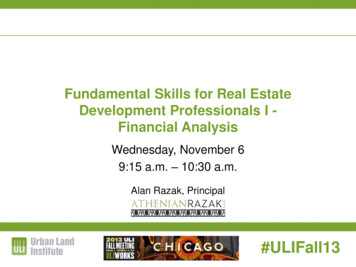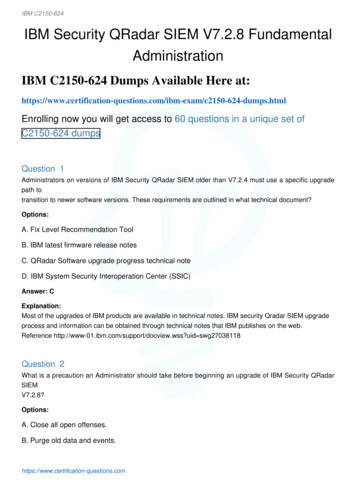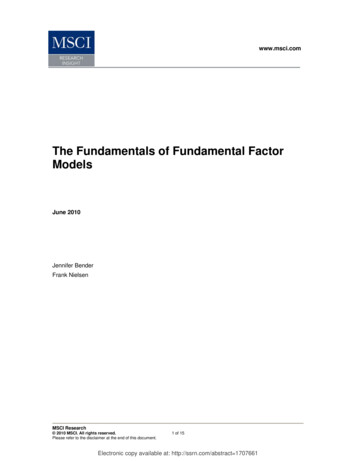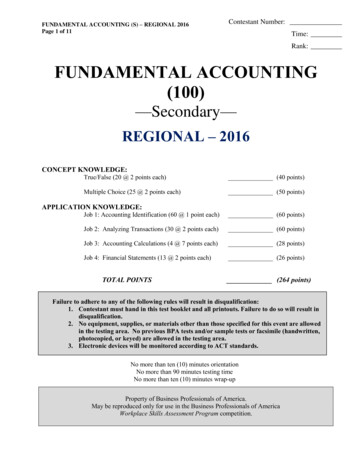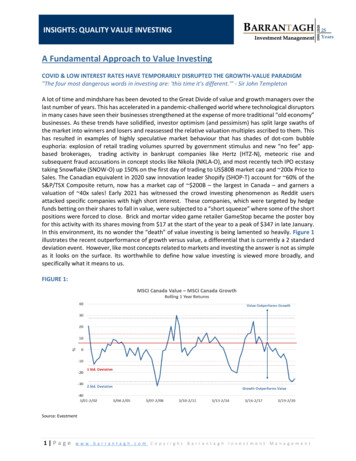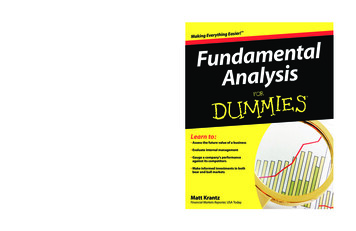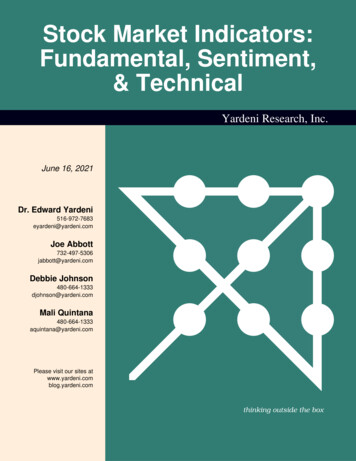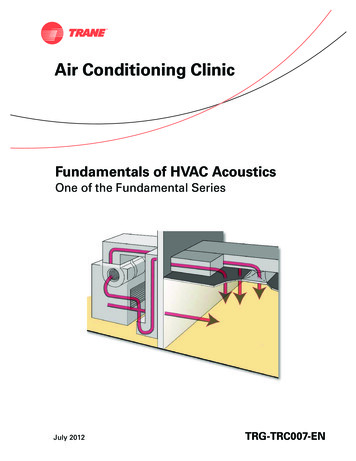
Transcription
Air Conditioning ClinicFundamentals of HVAC AcousticsOne of the Fundamental SeriesJuly 2012TRG-TRC007-EN
Fundamentals of HVACAcousticsOne of the Fundamental SeriesA publication of Trane
PrefaceFundamentals of HVAC AcousticsA Trane Air Conditioning ClinicFigure 1Trane believes that it is incumbent on manufacturers to serve the industry byregularly disseminating information gathered through laboratory research,testing programs, and field experience.The Trane Air Conditioning Clinic series is one means of knowledge sharing.It is intended to acquaint a nontechnical audience with various fundamentalaspects of heating, ventilating, and air conditioning (HVAC). We have takenspecial care to make the clinic as uncommercial and straightforward aspossible. Illustrations of Trane products only appear in cases where they helpconvey the message contained in the accompanying text.This particular clinic introduces the reader to the fundamentals of HVACacoustics.ii 2001 Trane. All rights reservedTRG-TRC007-EN
Contentsperiod oneFundamentals of Sound . 1What is Sound? . 2Octave Bands . 6Sound Power and Sound Pressure . 9period twoSound Perception and Rating Methods . 15Human Ear Response . 15Single-Number Rating Methods . 17Octave-Band Rating Method . 28period three Acoustical Analysis . 29Setting a Design Goal . 30Source–Path–Receiver Analysis . 32Sound-Path Modeling . 37Terms Used in Sound-Path Modeling . 41period fourEquipment Sound Rating . 47Fields of Measurement . 48HVAC Equipment Sound Rating . 54period fiveReview . 63Quiz . 68Answers . 70Glossary . 71TRG-TRC007-ENiii
ivTRG-TRC007-EN
period oneFundamentals of SoundnotesFundamentals of HVAC Acousticsperiod oneFundamentals of SoundFigure 2People have become increasingly conscious of acoustics as a component of acomfortable environment. Sound levels, both indoor and outdoor, can beaffected to varying degrees by HVAC equipment and systems.The degree to which the HVAC system affects the sound at a particular locationdepends on the strength of the sound source and the environmental effects onthe sound as it travels from that source to the listener.TRG-TRC007-EN1
period oneFundamentals of SoundnotesWhat is Sound? Audible emissions resulting from vibration ofmolecules within an elastic medium Generated by vibrating surface or movementof a fluid In buildings, it may be airborne or structureborne Noise is unwanted soundFigure 3What is Sound?Sound is the audible emissions resulting from the vibration of moleculeswithin an elastic medium. It is generated by either a vibrating surface or themovement of a fluid. In the context of building HVAC systems, this elasticmedium can be either air or the building structure. For structurally-borne soundto become audible, however, it must first become airborne.Noise is different than sound. Sound is always present, but is not alwaysobtrusive. Noise is defined as unwanted sound. Generally, people object tosound when it interferes with speech, concentration, or sleep.2TRG-TRC007-EN
period oneFundamentals of SoundnotesSound Wave and Frequencyone cycleamplitude frequency, Hz cyclesseconds-timeFigure 4Airborne sound is transmitted away from a vibrating body through the transferof energy from one air molecule to the next. The vibrating body alternatelycompresses and rarefies (expands) the air molecules. The pressure fluctuationsthat result from the displacement of these air molecules take the form of aharmonic, or sine, wave. The amplitude of the wave depicts pressure. Thehigher the amplitude, the louder the sound.This transfer of energy takes time. Each complete sequence of motion(compression and rarefaction) constitutes a cycle, and the time required tocomplete one cycle is the cycle period. The frequency of the periodic motion isthe number of cycles that occur in a second. The unit of measure for frequencyis the hertz (Hz). One hertz is equal to one cycle per second.cyclesfrequency, Hz ----------------------secondsThe terms pitch and frequency are often (incorrectly) used interchangeably.Frequency is an objective quantity that is independent of sound-pressure level.Pitch, however, is a subjective quantity that is primarily based on frequency,but is also dependent on sound-pressure level and composition. Pitch is notmeasured, but is described with terms like bass, tenor, and soprano.TRG-TRC007-EN3
period oneFundamentals of SoundnotesWavelengthone cyclewavelength speed of soundfrequencyFigure 5The wavelength of the sound is the linear measurement of one completecycle. The wavelength and frequency of a sound are related by using thefollowing equation:speed of soundwavelength yThe speed of sound transmission is a physical property of the medium. For air,the speed varies slightly with temperature change. Because the temperaturerange encountered in the study of HVAC acoustics is relatively small, the speedof sound can be considered a constant 1,127 ft/s (344 m/s). For example, soundtraveling through the air at a frequency of 200 Hz has a wavelength of 5.6 ft(1.7 m).1,127 ft/swavelength ------------------------- 5.6 ft200 Hzm/s wavelength 344-------------------- 1.7 m 200 Hz4TRG-TRC007-EN
period oneFundamentals of SoundnotesamplitudeBroadband SoundFigure 6timeThe wave form shown in Figure 5 represents sound occurring at a singlefrequency. This is called a pure tone.A pure sinusoidal wave form, however, is very rare in HVAC acoustics. Typically,sounds are of a broadband nature, meaning that the sound is composed ofseveral frequencies and amplitudes, all generated at the same time. Figure 6represents the components of broadband sound.Broadband Sound and Tonesamplitudetonefrequencylogarithmic scaleFigure 7Alternatively, plotting the amplitude (vertical axis) of each sound wave at eachfrequency (horizontal axis) results in a graphic of the broadband sound thatlooks like this. As you can see from this example, the sound energy is greater atsome frequencies than at others.TRG-TRC007-EN5
period oneFundamentals of SoundnotesAgain, a pure tone has a single frequency. If a sound in a narrow band offrequencies is significantly greater than the sound at adjacent frequencies, itwould be similar to a tone. Tones that stand out enough from the backgroundsound can be objectionable. Many of the sounds generated by HVACequipment and systems include both broadband and tonal characteristics.Octave Bandscenterfrequency (Hz)frequencyrange (Hz)16345 to 90212590 to 1803250180 to 3554500355 to 71051,000710 to 1,40062,0001,400 to 2,80074,0002,800 to 5,60088,0005,600 to 11,200octavebandFigure 8Octave BandsBecause sound occurs over a range of frequencies, it is considerably moredifficult to measure than temperature or pressure. The sound must bemeasured at each frequency in order to understand how it will be perceived in aparticular environment. The human ear can perceive sounds at frequenciesranging from 20 to 16,000 Hz, whereas, HVAC system designers generally focuson sounds in the frequencies between 45 and 11,200 Hz. Despite this reducedrange, measuring a sound at each frequency would result in 11,156 data points.For some types of analyses, it is advantageous to measure and display thesound at each frequency over the entire range of frequencies being studied.This is called a full-spectrum analysis and is displayed like the example shownin Figure 7.To make the amount of data more manageable, this range of frequencies istypically divided into smaller ranges called octave bands. Each octave band isdefined such that the highest frequency in the band is two times the lowestfrequency. The octave band is identified by its center frequency, which iscalculated by taking the square root of the product of the lowest and highestfrequencies in the band.center frequency lowest frequency highest frequencyThe result is that this frequency range (45 to 11,200 Hz) is separated into eightoctave bands with center frequencies of 63, 125, 250, 500, 1,000, 2,000, 4,000,and 8,000 Hz. For example, sounds that occur at the frequencies between 90 Hzand 180 Hz are grouped together in the 125 Hz octave band.6TRG-TRC007-EN
period oneFundamentals of SoundnotesOctave Bandsamplitudelogarithmicsums63125 250500 1,000 2,000 4,000 8,000frequency, HzFigure 9Octave bands compress the range of frequencies between the upper and lowerends of the band into a single value. Sound measured in an octave band is thelogarithmic sum of the sound level at each of the frequencies within the band.Unfortunately, octave bands do not indicate that the human ear hears adifference between an octave that contains a tone and one that does not, evenwhen the overall magnitude of both octaves is identical. Therefore, the processof logarithmically summing sound measurements into octave bands, thoughpractical, sacrifices valuable information about the “character” of the sound.TRG-TRC007-EN7
period oneFundamentals of SoundnotesamplitudeOne-Third Octave Bands63125 250500 1,000 2,000 4,000 8,000frequency, HzFigure 10Middle ground between octave-band analysis and full-spectrum analysis isprovided by one-third octave-band analysis. One-third octave bands dividethe full octaves into thirds. The upper cutoff frequency of each third octave isgreater than the lower cutoff frequency by a factor of the cube root of two(approximately 1.2599). If tones are contained in the broadband sound, they willbe more readily apparent in the third octaves.The use of octave bands is usually sufficient for rating the acousticalenvironment in a given space. One-third octave bands are, however, moreuseful for product development and troubleshooting acoustical problems.8TRG-TRC007-EN
period oneFundamentals of SoundnotesSound Power and Sound Pressure Sound power Acousticalenergy emitted by the sound source Unaffected by the environmentSound pressure Pressuredisturbance in the atmosphere Affectedby strength of source, surroundings, anddistance between source and receiverFigure 11Sound Power and Sound PressureSound power and sound pressure are two distinct and commonly confusedcharacteristics of sound. Both are generally described using the term decibel(dB), and the term “sound level” is commonly substituted for each. Tounderstand how to measure and specify sound, however, one must firstunderstand the difference between these two properties.Sound power is the acoustical energy emitted by the sound source, and isexpressed in terms of watts (W). It is not affected by the environment.Sound pressure is a pressure disturbance in the atmosphere, expressed interms of pascals (Pa), that can be measured directly. Sound pressure magnitudeis influenced not only by the strength of the source, but also by thesurroundings and the distance from the source to the listener. Sound pressureis what our ears hear and what sound meters measure.While sound-producing pressure variations within the atmosphere can bemeasured directly, sound power cannot. It must be calculated from soundpressure, knowing both the character of the source and the modifyinginfluences of the environment.TRG-TRC007-EN9
period oneFundamentals of SoundnotesAn Analogy Sound power Correlates to bulb wattageSound pressure Correlatesto brightnessFigure 12The following comparison of sound and light may help illustrate the distinctionbetween these two properties. Think of sound power as the wattage rating of alight bulb. Both measure a fixed amount of energy. Whether you put a 100-wattlight bulb outdoors or in a closet, it is always 100-watt light bulb and alwaysgives off the same amount of light.Sound pressure corresponds to the brightness, from the light emitted by thelight bulb, in a particular location in the room. Both sound pressure andbrightness can be measured with a meter, and the immediate surroundingsinfluence the magnitude of each. In the case of light, brightness depends onmore than the wattage of the bulb. It also depends on how far the observer isfrom the light bulb, the color of the room, how reflective the wall surfaces are,and whether the light bulb is covered with a shade. These other factors affecthow much light reaches the receiver, but do not affect the wattage of the lightbulb.Similarly, sound pressure depends not only on the sound power emitted by thesource, but also on the characteristics of the surrounding environment. Thesemight include the distance between the sound source and the listener, whetherthe room is carpeted or tiled, and whether the room is furnished or bare. Just aswith light, environmental factors like these affect how much sound reaches thelistener.10TRG-TRC007-EN
period oneFundamentals of SoundnotesDecibeldB 10 log10measured valuereference valueFigure 13Sounds encompass a wide range of volumes, or levels. The loudest sound thehuman ear can hear without damage due to prolonged exposure is about1,000,000,000 times greater than the quietest perceptible sound. A range of thismagnitude makes using an arithmetic scale cumbersome, so a logarithmicscale is used instead.The measurement of sound level is expressed in terms of decibels (dB), adimensionless quantity.
Fundamentals of Sound People have become increasingly conscious of acoustics as a component of a comfortable environment. Sound levels, both indoor and outdoor, can be affected to varying degrees by HVAC equipment and systems. The degree to which the


